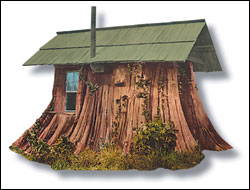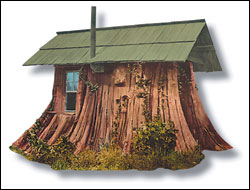The face of the earth is no longer a sponge, but a dust heap . . . rendered no longer fit for the habitation of man.
—George Perkins Marsh, Man and Nature, 1864
It’s not like we didn’t have any warning. In the ’60s—the 1860s, mind you—George Perkins Marsh wrote the first book on what was to become the field of ecology and joined a long line of Cassandras who give warnings that we ignore, but which prove to be accurate.
Worried about the land-use practices in 19th-century Vermont and finding lessons in the vast deserts of the Old World where empires had been reduced to ruins and dunes, Marsh laid out the concept that nature is deeply interconnected and that human misbehavior can reap terrible consequences. “There are parts of Asia minor, of Northern Africa, of Greece, and even of Alpine Europe, where the operation of causes set in action by man has brought the face of the earth to a desolation almost as complete as that of the moon. . . ,” Marsh wrote.
He was alarmed by the agricultural, forestry, and settlement practices in America, too, a place where pioneers thought little of leveling forests, playing out the land, then heading out West to do it all again. Marsh worried about the itinerant nature of our society. How can people who won’t grow to middle age in the houses they grew up in ever learn to tend the land for future generations? As we know—and need reminding of in this time of global climate change—that tension between our short-term desires and long-term responsibilities still thickens the air of American affairs.
So, we can ignore George Perkins Marsh or Rachel Carson or even Al Gore, but we can’t dodge the consequences of the future we’re making. Nature won’t let us. Hurricane Katrina is a case in point, a multibillion-dollar disaster that destroyed New Orleans. It was made worse by human behavior and government policy. That included the exploitation of the Gulf Coast to power an energy industry that’s contributing to global warming, a pheno-menon that could well produce even worse storms down the road.
Katrina isn’t the first such disaster in this country. As Timothy Egan reminds us in The Worst Hard Time: The Untold Story of Those Who Survived the Great American Dust Bowl (Houghton Mifflin, $28), the 1930s saw a “perfect storm” of biblical proportions. In the 1930s, the Dust Bowl resulted from a terrible collision of weather, the Great Depression, bad farming, and a desperate rural population seeking the American dream in the last, and worst, unsettled homestead country, the harsh no-man’s-land of the high plains of Texas, Oklahoma, and Kansas.
You may think you know about the Dust Bowl, a black-and-white newsreel tragedy that comes with a Woody Guthrie soundtrack and images of Ma and Pa and the kids and all their possessions packed into a truck heading for California. But Egan’s story isn’t about the refugees that John Steinbeck and Hollywood made famous. It’s the grittier tale of the Dust Bowlers who stayed behind. Egan takes you inside the whirlwind to hear from the eyewitnesses who faced, as one called it, “the hate of all nature.”
Of course, it wasn’t hate but human ignorance that helped to make the Dust Bowl. The U.S. government had encouraged the settlement and stripping of the vast inland sea of prairie grass that had held the earth in place for millennia. The land that had supported millions of buffalo was crudely plowed up, exposed to the ravages of the plain’s notorious high winds and drought cycles. In the so-called “dirty thirties,” the region was raked by dust storms the like of which no one on the continent had ever seen. Electrically charged black clouds swept down, like dry, crackling tsunamis that rolled over the land. Up to 100 million acres were devastated and more than a quarter- million people displaced. On Black Sunday, April 14, 1935, Egan tells us that a single dust storm carried twice as much dirt as was dug up for the Panama Canal. It fell to earth in choking clouds that penetrated every pore and crevice; it swept into dunes that suffocated the High Plains and its people.
Egan is a Seattle-based reporter for The New York Times, a Pulitzer winner, and author of several books about the West, including the Northwest classic The Good Rain. I’ve known him for 20 years, and have had the pleasure to edit his contributions to a couple of local publications, including this one. A hallmark of his style is his storytelling ability, his skill at spotting human details and tying them to the big picture. He can lasso a story line better than anyone and does so here in a way that dramatizes the big picture but also enlivens it with a cast of characters that includes homesteaders, hucksters, rainmakers, and policy makers. He takes you inside the sod huts of the hunkered-down farmers who coped with dust, constant winds, extreme heat and cold, locusts, tarantulas . . . even cows that could not be milked because their udders were too sore from sandblasting. Call it Little House on Job’s Prairie.
The good news is that many survived to tell the tale, and Egan traveled to the region and interviewed the elders who still remember the way it was. The better news, as Egan writes, is that while federal policies contributed to the disaster, the feds also led a recovery. Facing a decision that echoes the policy debate in the aftermath of Katrina—to rebuild or cut losses—Franklin D. Roosevelt launched a New Deal initiative to start the soil conservation movement to re-educate farmers and bring life back to the land instead.
Learning not to cut and run is a good thing, even more important now that modern technology allows us to make global mistakes. There is no running from this planet—at least not yet. We humans are dogged in recovery, but wouldn’t it be nice if we could learn to avoid making such messes in the first place? The sobering thing about The Worst Hard Time is that the human folly it documents is so damned familiar today, and someday it just might outweigh our human strengths.
Tim Egan will appear at Elliott Bay Book Co., 7:30 p.m. Thurs., Dec. 15.








